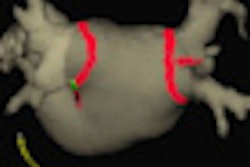A new research study may fire up the debate over a possible link between preoperative breast MRI and higher mastectomy rates. Texas researchers found that at their facility, patients were almost twice as likely to have a mastectomy if breast MRI was used before surgery. But breast MRI didn't delay treatment, they found.
Recent research has been mixed on the relationship between breast MRI and mastectomy rates, with some studies finding higher mastectomy rates when breast MRI is used while others found no association. Some experts theorize that breast MRI detects abnormalities that are of so much concern to doctors and patients that they opt for total removal of the breast rather than a lumpectomy.
The question was addressed by a research team led by Dr. Kevin Clive, a third-year surgical resident at Brooke Army Medical Center in Fort Sam Houston and colleagues, who looked at their experience with breast MRI at their facility. The study is being presented at the Academic Surgical Congress, a joint meeting of the Association for Academic Surgery (AAS) and the Society of University Surgeons (SUS) that's being held this week in San Antonio.
Finding hidden disease
MRI has been shown to detect hidden disease in roughly 3% of recently diagnosed breast cancer patients, and the modality has been proposed as a means to improve the application and practice of breast-conserving therapy, Clive and colleagues wrote. But clinical data also suggest that using MRI delays surgical treatment, increases the mastectomy rate, and does not improve surgical margin status.
Clive's team performed a retrospective review of Brooke Army Medical Center's database of all new breast cancer patients seen in the hospital's multidisciplinary breast cancer clinic since 2007. The database includes demographic, pathologic, treatment, and outcome parameters, and the study included 157 women. (In 2008, Brooke Army Medical Center began routine use of pretreatment MRI for newly diagnosed breast cancer patients.)
Of the 157 patients, 71 (45%) had pretreatment MRI and 86 (55%) did not. Mean age in the MRI group was 59 years, and mean age in the control group was 58. The team found that the mastectomy rate in the group of patients who received pretreatment MRI was 53%, while the rate in the control group -- those who did not receive pretreatment MRI -- was 29%.
In other findings, the researchers noted more ductal carcinoma in situ (DCIS) in the control group than in the MRI group (39.5% versus 19.7%), which it attributed to MRI's limitations in detecting DCIS. The mean elapsed time between diagnosis and surgery was 24 days in the MRI group versus 26 days in the control group.
Can delay be avoided?
Another argument that's sometimes raised against breast MRI is that it can delay treatment: An August 2009 study published in the Journal of the American College of Surgeons found that patients who received breast MRI experienced a 22-day delay in the start of their treatment. That wasn't the case at Brooke Army Medical Center.
"We have a unique system at our facility that allows us to incorporate MRI into our diagnostic algorithm without a significant delay in treatment," he said. "We were happy to find that there was no delay, as we had suspected."
On another point, Clive and colleagues expected that improved detection of multifocal/multicentric disease and more accurate determination of tumor size through breast MRI would improve operative planning and minimize the need for re-excisions. However, there was no statistically significant difference. For breast-conserving therapy candidates, re-excisions for close (< 1 mm) or positive margins were required in 24% of the MRI group, compared with 34% in the control group.
Despite the study's mixed results, Brooke Army Medical Center will continue to use MRI as a pretreatment tool, Clive said.
"It is important to counsel patients as to what we know about breast MRI, and how it has impacted our management of breast cancer," he said. "It does seem to identify more multifocal/multicentric disease and, thus, increases mastectomy rates. The true utility of MRI will play out as we continue to follow these groups long-term, looking at the women's disease-free and overall survival."
By Kate Madden Yee
AuntMinnie.com staff writer
February 4, 2010
Related Reading
MRI helps find hidden breast cancer, even after US and mammo, January 5, 2010
Nearly half of women decline breast MRI, December 30, 2009
Study challenges breast MRI scans, June 26, 2009
No rise in mastectomy rates with greater use of breast MRI, April 28, 2009
Rates of prophylactic mastectomy for DCIS rising in U.S., April 24, 2009
Copyright © 2010 AuntMinnie.com



.fFmgij6Hin.png?auto=compress%2Cformat&fit=crop&h=100&q=70&w=100)





.fFmgij6Hin.png?auto=compress%2Cformat&fit=crop&h=167&q=70&w=250)











